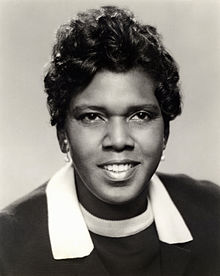Barbara Jordan | |
|---|---|
 | |
| Member of the U.S. House of Representatives from Texas's 18th district | |
| In office January 3, 1973 – January 3, 1979 | |
| Preceded by | Bob Price |
| Succeeded by | Mickey Leland |
| Member of the Texas Senate from the 11th district | |
| In office January 10, 1967 – January 3, 1973 | |
| Preceded by | Bill Moore |
| Succeeded by | Chet Brooks |
| Personal details | |
| Born | Barbara Charline Jordan February 21, 1936 Houston, Texas, U.S. |
| Died | January 17, 1996 (aged 59) Austin, Texas, U.S. |
| Political party | Democratic |
| Domestic partner | Nancy Earl (late 1960s–1996) |
| Education | Texas Southern University (BA) Boston University (LLB) |
Barbara Charline Jordan (February 21, 1936 – January 17, 1996) was an American lawyer, educator,[1] and politician. A Democrat, she was the first African American elected to the Texas Senate after Reconstruction, the first Southern African-American woman elected to the United States House of Representatives,[2][3] and one of the first two African Americans elected to the U.S. House from the former Confederacy since 1901, alongside Andrew Young of Georgia.
Jordan achieved notoriety for delivering a powerful opening statement[4] at the House Judiciary Committee hearings during the impeachment process against Richard Nixon. In 1976, she became the first African American, and the first woman, to deliver a keynote address at a Democratic National Convention.[5] Jordan is also known for her work as chair of the U.S. Commission on Immigration Reform. She received the Presidential Medal of Freedom, among numerous other honors. She was the first African-American woman to be buried in the Texas State Cemetery.[6][7]
- ^ Finkelman, Paul (2009). Encyclopedia of African American History 1896 to the Present: From the Age of Segregation to the Twenty-First Century. New York: Oxford University Press. pp. 59–61. ISBN 978-0-19-516779-5.
- ^ Clines, Francis X. (January 18, 1996). "Barbara Jordan Dies at 59; Her Voice Stirred the Nation". The New York Times. ISSN 0362-4331. Retrieved October 22, 2016.
- ^ Martin, D.R., & Martin, V.G. (1984). Barbara Jordan's symbolic use of language in the keynote address to the national women's conference. Southern Speech Communication Journal, 49(3), 319-330. https://doi.org/10.1080/10417948409372609
- ^ "JORDAN, Barbara Charline | US House of Representatives: History, Art & Archives". history.house.gov. Retrieved October 22, 2016.
- ^ Curtin, M.E. (2004) Barbara Jordan: The politics of insertion and accommodation, Critical Review of International Social and Political Philosophy, 7(4), 279-303, https://doi.org/10.1080/1369823042000300117
- ^ "Barbara Jordan". Humanities Texas. Retrieved February 18, 2016.
... When she died, in 1996, her burial in the Texas State Cemetery marked yet another first: she was the first black woman interred there.
- ^ Wilson, Scott. Resting Places: The Burial Sites of More Than 14,000 Famous Persons, 3d ed.: 2 (Kindle Location 24267). McFarland & Company, Inc., Publishers. Kindle Edition